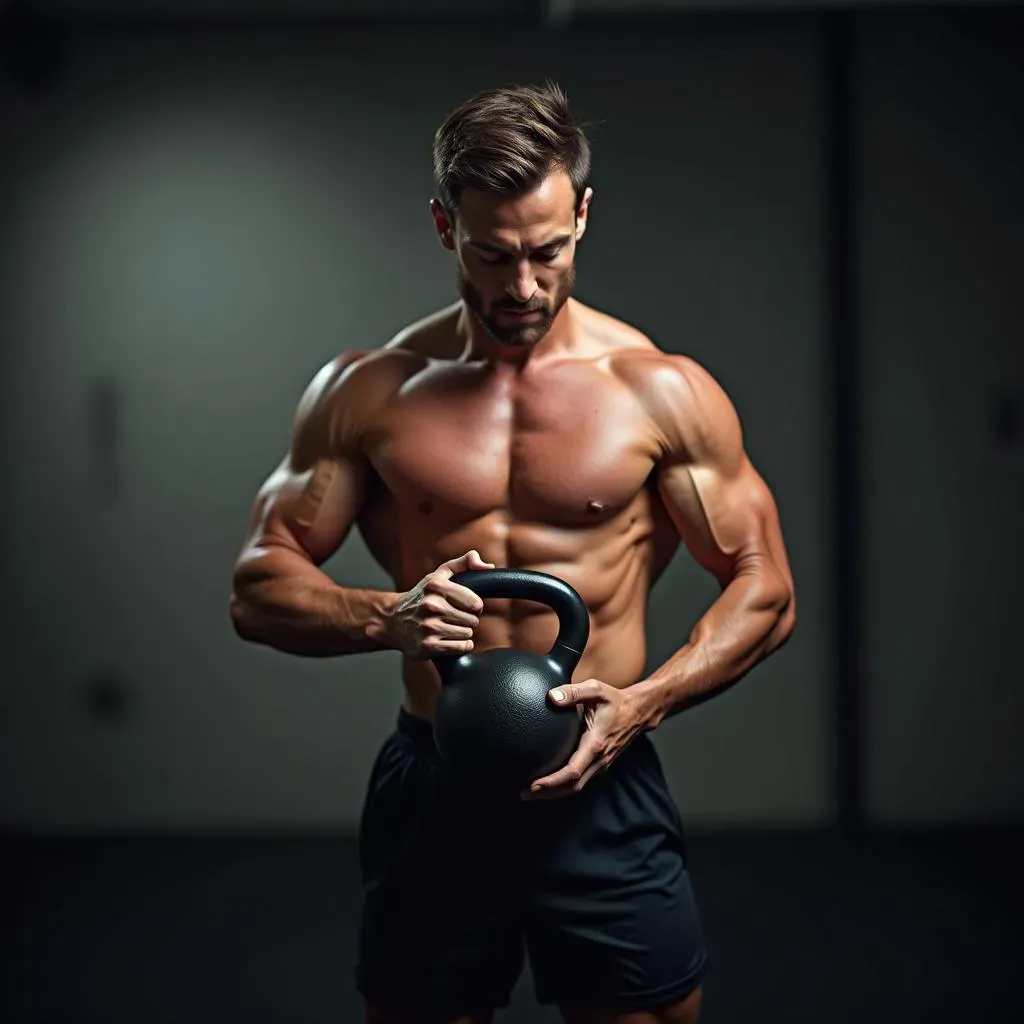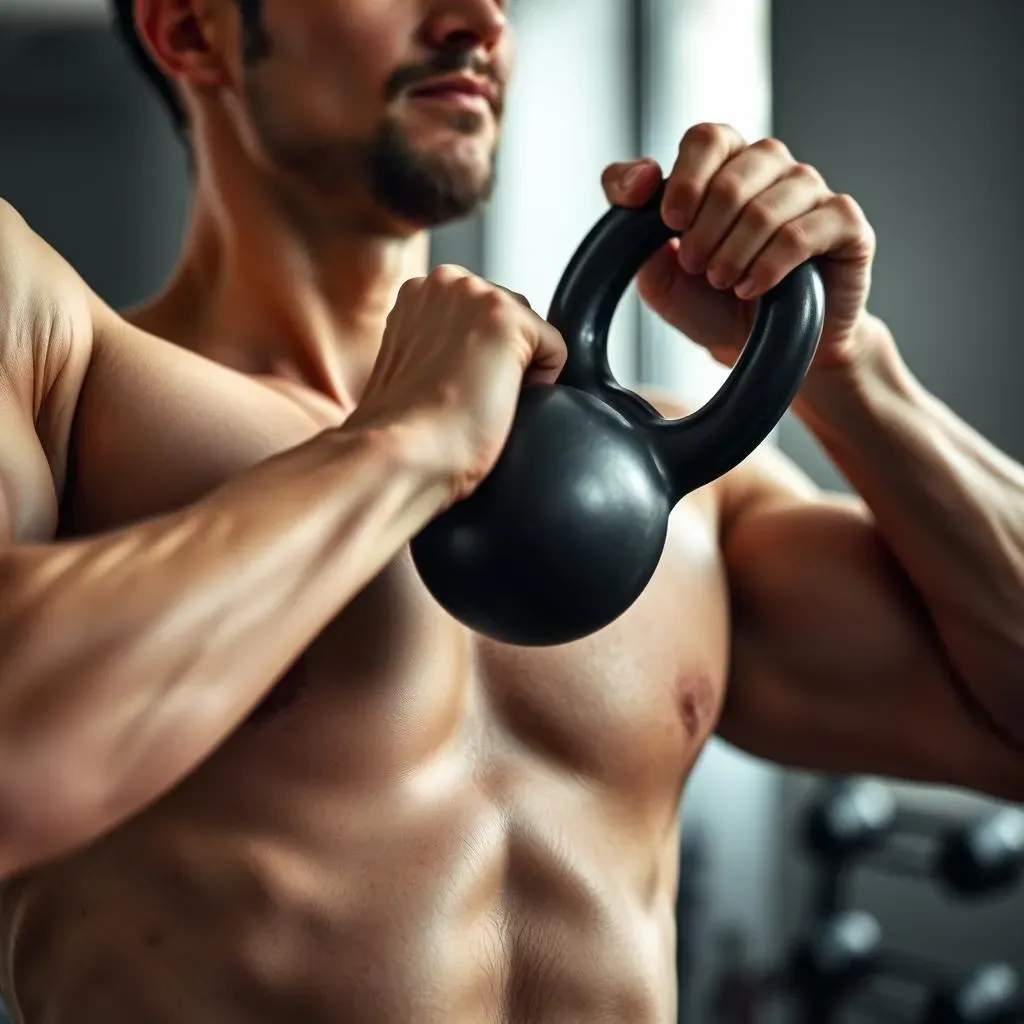Table of Contents
Ready to ditch the boring bench press? Let's talk about something that'll really shake up your chest day: kettlebell chest workouts. Forget those clunky dumbbells for a minute; kettlebells bring a whole new level of challenge and fun to building a powerful chest. I'm not saying barbells are bad, but kettlebells? They force your muscles to work harder, creating a more stable and functional physique. This isn't just about lifting weight; it's about controlling it, and that makes a huge difference. In this article, we'll explore why kettlebells are fantastic for your chest, then we'll get into five killer exercises that'll have your pecs screaming for mercy (in a good way, of course). We will also cover proper form because, let's be honest, nobody wants a shoulder injury. Finally, I'll give you tips to keep the gains coming. So, if you are ready to build a chest that would make a silverback gorilla jealous, keep reading, it is going to be good.
Why Choose Kettlebell Chest Workouts?

Why Choose Kettlebell Chest Workouts?
More Than Just a Weight
so you're probably thinking, "Why kettlebells?" I get it. Barbells and dumbbells are the usual suspects in the gym, but kettlebells are like the cool, slightly rebellious cousin that shows up and steals the show. They're not just weights; they're tools that challenge your body in a way that forces it to adapt and grow. Think about it: the offset handle and the shape of the kettlebell demand more from your stabilizing muscles. This means you're not just working your chest; you're also firing up your core, shoulders, and even your grip. It's like a full-body party, and your chest is the guest of honor.
Plus, kettlebells offer a unique range of motion compared to traditional weights. This can help with better muscle activation and can sometimes feel more natural for some people. I know when I first started, bench pressing felt a little awkward. But the kettlebell floor press? It just clicked. It felt more like a natural extension of my body, which made the workout feel more connected and effective. You aren't just lifting a weight; you are working with it, and that's a game-changer.
Functional Strength and Real-World Benefits
Let's be real, most of us aren't training to be powerlifters. We want a chest that looks good, yeah, but we also want one that's functional. Kettlebells excel at this. The exercises mimic real-life movements, which translates to better performance in everyday activities. Think about pushing a heavy door open or carrying groceries—those actions use similar muscle patterns as kettlebell chest exercises. So, not only are you building a killer chest, but you're also making your everyday life easier. It's a win-win.
Another awesome benefit? Kettlebells are super versatile and portable. You can take them anywhere. I've done workouts in my living room, in the park, and even on vacation. No need for a fancy gym membership. This flexibility makes it easier to stick to your routine and that is the key to making progress. Plus, they are just fun! There is something about swinging a kettlebell that makes you feel like a total badass.
Benefit | Description |
|---|---|
Full-Body Engagement | Kettlebells activate more muscles than just your chest. |
Enhanced Stability | The offset weight improves core and shoulder stability. |
Functional Strength | Movements mimic real-life actions, improving everyday performance. |
Versatility and Portability | Easy to use anywhere, anytime. |
Increased Fun | Makes working out more enjoyable. |
Top 5 Kettlebell Chest Exercises for Growth

Top 5 Kettlebell Chest Exercises for Growth
The Kettlebell Floor Press
Alright, let's get into the good stuff: the exercises. First up, we have the kettlebell floor press. This is like the bread and butter of kettlebell chest work. It's simple, effective, and you don’t need a fancy bench to do it. Just lie down on the floor, grab your kettlebell, and press it up. The floor provides some stability, which allows you to focus on pushing through your chest. I like this exercise because it really gets my pecs engaged. When I do this, I feel a deep burn that tells me it's working. Also, since you're on the floor, it's easier on your shoulders, which is a nice bonus.
When you're doing the floor press, make sure your elbow is at about a 45-degree angle to your body. Don't let it flare out. Think about pushing the kettlebell away from you, rather than just up. Focus on squeezing your chest at the top of the movement. You'll feel the difference. And, as always, control the weight on the way down. No dropping! You want to work the muscles in both directions.
Kettlebell Flyes: A Chest Stretch
Next, let’s talk about kettlebell flyes. Now, these are a bit different from your typical dumbbell flyes. With kettlebells, you get a different kind of challenge because of the way the weight is distributed. You'll lie on the floor, holding a kettlebell in each hand, and then lower them out to the sides, feeling a good stretch in your chest. Then bring them back up, squeezing your pecs. This exercise is all about control and feeling the stretch and contraction in your chest muscles. I've found that this exercise is great for hitting the chest from a slightly different angle.
The key here is to keep a slight bend in your elbows. You're not trying to go super heavy here; it's more about the stretch and squeeze. If your ego is trying to make you go heavy, tell that ego to take a seat. You want to feel the stretch in your chest, not strain your shoulders. Start with a light weight and really focus on the movement. Once you have that down, you can slowly add more weight as you get stronger. Remember, it's about quality, not quantity. The mind-muscle connection is key with kettlebell flyes.
Exercise | Why it's Great |
|---|---|
Kettlebell Floor Press | Simple, effective, great for beginners, easy on the shoulders. |
Kettlebell Flyes | Provides a great chest stretch, hits the chest from a different angle. |
Mastering Kettlebell Chest Exercises: Form and Technique

Mastering Kettlebell Chest Exercises: Form and Technique
The Grip Matters
so you've got your kettlebell, you're ready to go, but hold up a sec. Your grip is super important. I see people all the time grabbing those handles like they're trying to strangle a snake, and that's just not how it's done. You want a firm but relaxed grip. Think about gripping the handle with your fingers, not your whole hand. This will help you control the kettlebell better and engage the right muscles. When I first started, I was gripping so hard, my forearms would cramp up before my chest even felt anything. So, take it from me, relax your grip and focus on the movement. It makes a world of difference.
Also, think about where the kettlebell sits in your hand. You want the handle to be resting in the meaty part of your palm, not up by your fingers. If you have it too high, it can put a lot of stress on your wrists and make the exercise feel awkward. A proper grip will help you keep the kettlebell stable and allow you to generate more power in your chest. So, before you even start the exercise, take a moment to adjust your grip. It might seem like a small thing, but it's key to a good workout.
Slow and Controlled Movements
Another thing I always emphasize is to control the movement. I see people rushing through their reps, just flinging the kettlebell around, and they're not really getting the most out of the exercise. You want to go slow and controlled, both when you're lifting and when you're lowering the weight. It's tempting to want to lift as fast as possible, but that's just feeding your ego. When you move slowly, you keep the muscles under tension for longer, which is what leads to growth. Think of it like this: you're not just lifting the weight, you're also resisting it. That resistance is where the magic happens.
For example, when you're doing the floor press, don't just drop the kettlebell back down to the floor. Slowly lower it, feeling the stretch in your chest. Then, when you press it back up, focus on squeezing your pecs at the top of the movement. This slow, controlled motion will make your muscles work so much harder. It's not about how fast you can do it; it's about how well you can do it. Focus on quality over quantity, and you'll see better results. Trust me, your chest will thank you for it.
Form Tip | Why It Matters |
|---|---|
Relaxed Grip | Prevents forearm cramps, improves control. |
Palm Placement | Reduces wrist stress, enhances stability. |
Slow Movements | Increases time under tension, boosts muscle growth. |
Progressing Your Kettlebell Chest Workouts

Progressing Your Kettlebell Chest Workouts
The Progressive Overload
so you've nailed the form, you're feeling the burn, and you're starting to see some growth. What's next? Well, this is where we talk about progressive overload. It's a fancy term, but it just means that you need to keep challenging your muscles to keep them growing. Your body is super smart, and it adapts quickly, so if you keep doing the same workout over and over, your progress will eventually stall. You can't just keep using the same weight for the same reps forever. Think of it like this: if you are always lifting the same weight, it is like your muscles are saying "Oh, this again?".
The most basic way to do this is by adding more weight. Once you can comfortably do all your sets and reps with good form, it's time to grab a heavier kettlebell. But, here's the thing about kettlebells: the weight jumps can be quite big. You might have a 16kg kettlebell and then the next one up is 20kg, and that's a big jump. If you can't make the jump, that's fine! There are other ways to progress. You can increase your reps. If you're doing 3 sets of 8, try doing 3 sets of 10, or 12. Or you can increase your sets. If you're doing 3 sets, try doing 4. The key is to make the workouts harder over time. Your muscles will thank you for it by getting bigger and stronger.
Double Progression: Reps and Sets
So, you're probably thinking, " I get it, more weight, more reps, but how do I know when to increase?". This is where the concept of double progression comes in. It's a simple but effective method. Let's say you're aiming for 3 sets of 8-12 reps of the kettlebell floor press. You start with a weight that allows you to do 8 reps for all 3 sets. The next time, you try to hit 9 reps, then 10, and so on, until you can do 12 reps for all sets. Once you can nail 3 sets of 12 reps with good form, that's when you increase the weight. It's a nice way to break down the progression and to make sure you are making steady improvement.
Double progression is not just about adding weight, it's about making gradual changes. It's about listening to your body and making small adjustments over time. It's also about not being afraid to fail. Sometimes, you'll try to add a rep or a set and you won't be able to do it. That's okay! Just keep trying. The key is consistency. If you show up to the gym and do your best, you will see results. Don't be afraid to experiment with what works for your body. After all, this is your journey, so make it your own.
Progression Method | How to Implement |
|---|---|
Increase Weight | Add weight once you can hit your rep target. |
Increase Reps | Add reps each workout until you reach a target. |
Increase Sets | Add an extra set to your workout. |
Double Progression | Increase reps first, then increase weight. |
Wrapping Up Your Kettlebell Chest Journey
So, there you have it. Kettlebell chest workouts aren't just a trendy alternative; they're a legit way to build serious strength and muscle. From the floor press to the deficit push-up, these exercises challenge your chest in ways traditional weights can't. Remember, it's not just about lifting heavy, it’s about control, stability, and consistent effort. Don't be afraid to experiment, adjust your routine as needed, and most importantly, listen to your body. If you stick with it, you'll not only sculpt a chest that looks great but also build a stronger, more resilient you. Now, go grab those kettlebells and get to work, your chest is not going to build itself!